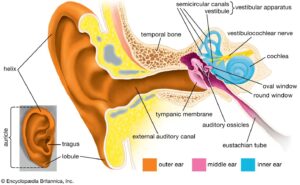Why Does my Ear Feel Clogged?
By Laura Noyes, NP
 Ear pain and clogging is a common reason for people to come to the doctor, especially in the winter months when upper respiratory infections are more common. Understanding the anatomy of the ear can help you understand what is causing this common problem. Your ear has 3 compartments, outer, middle and inner. The inner ear is a very complex structure so today we will focus on the outer and middle ears. The outer ear begins at the opening to your ear and travels back about 1 inch (in an adult) to the tympanic membrane (TM) aka the ear drum. In normal circumstances, the TM forms a seal. Nothing coming in from the outside gets past it.
Ear pain and clogging is a common reason for people to come to the doctor, especially in the winter months when upper respiratory infections are more common. Understanding the anatomy of the ear can help you understand what is causing this common problem. Your ear has 3 compartments, outer, middle and inner. The inner ear is a very complex structure so today we will focus on the outer and middle ears. The outer ear begins at the opening to your ear and travels back about 1 inch (in an adult) to the tympanic membrane (TM) aka the ear drum. In normal circumstances, the TM forms a seal. Nothing coming in from the outside gets past it.
When someone in a doctor’s office looks into your ear with an otoscope, they get an excellent view of your outer ear and a pretty good idea about what is going on in your middle ear. Looking at the TM is like looking through a steamy shower door. You can see vague structures through it. From the outside, you can see if there is a buildup of fluid or pus in the middle ear, and it often becomes red and bulges out if there is an infection. So, if the middle ear it sealed from the outside by the TM, where did that infection come from? The answer is most likely your throat. The middle ear has a back door called the eustachion tube that opens into the throat. When you get a cold, the eustachion tube can become swollen and blocked with mucus. This creates a clogging sensation in your ears, and can even make them more susceptible to a middle ear infection. Decongestants can help with the clogging. Most middle ear infections will clear up on their own, but in some cases an oral antibiotic may be used to treat that type of infection.
Outer ear problems can also cause clogging. Infections or wax buildup can block the outer ear. If you have drainage coming out of your ear, you either have an outer ear problem or your TM has ruptured. Outer ear problems are easy to diagnose in a doctor’s office and may be treated with lavage or antimicrobial drops.
